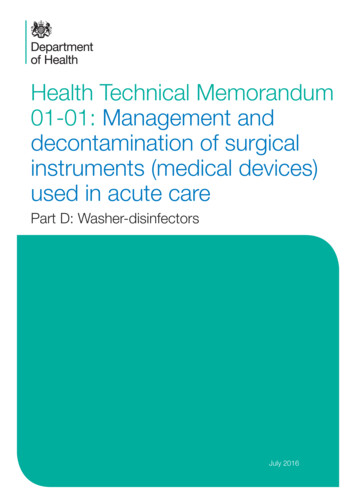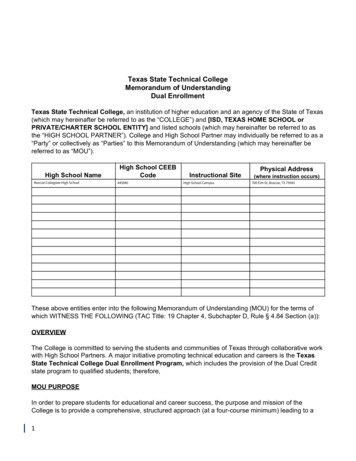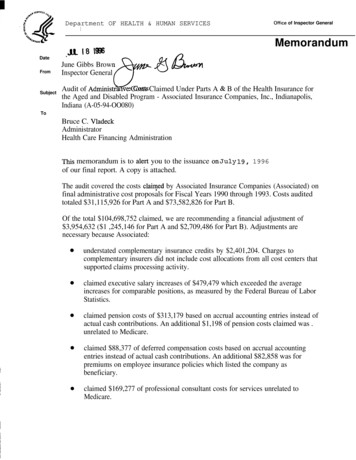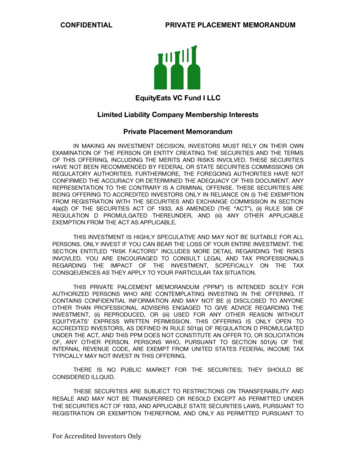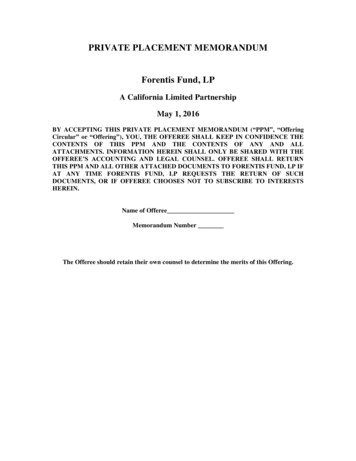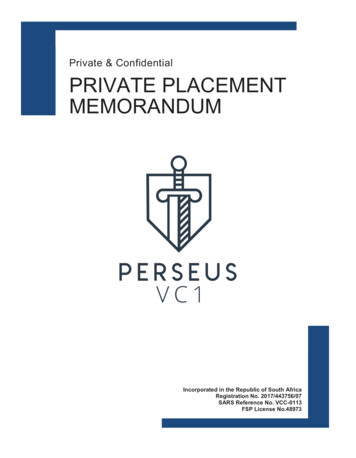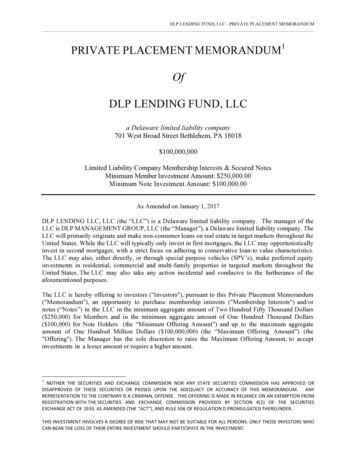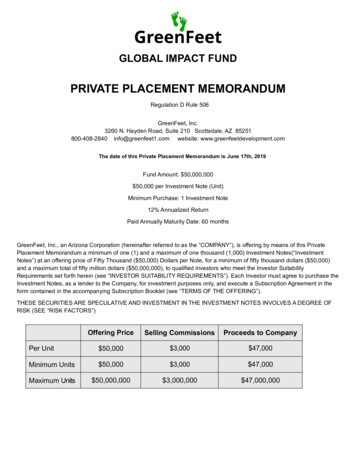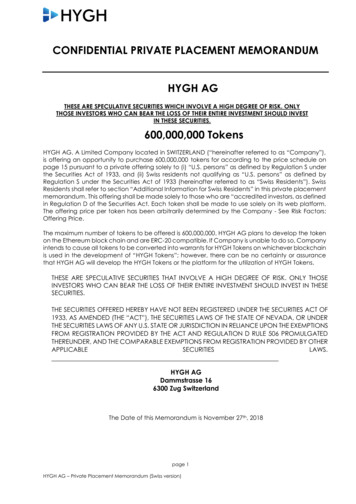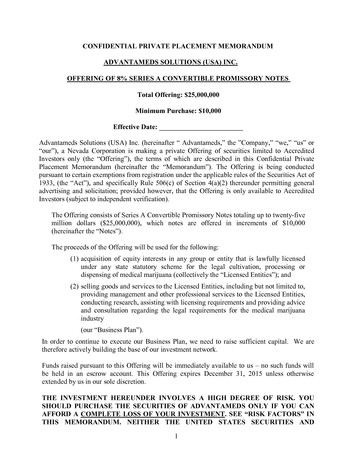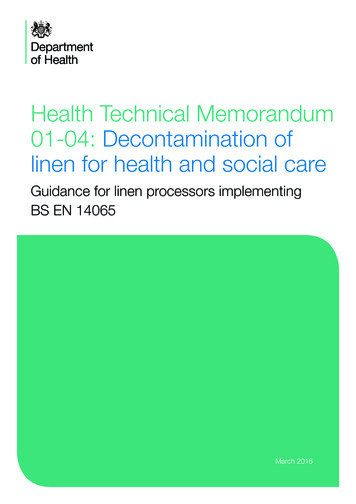
Transcription
Health Technical Memorandum01-04: Decontamination oflinen for health and social careGuidance for linen processors implementingBS EN 14065March 2016
HTM 01-04: Decontamination of linen for health and social care: Guidance for linen processors implementing BS EN 14065Health Technical Memorandum01-04: Decontamination of linenfor health and social careGuidance for linen processors implementingBS EN 14065ii
Crown copyright 2016You may re-use this information (not including logos) free of charge in any format or medium, under the terms of the Open Government Licence. To view this licence, visit www.nationalarchives. gov.uk/doc/open-government-licence/ or write to the Information PolicyTeam, The National Archives, Kew, London TW9 4DU, or email: psi@nationalarchives.gsi.gov.uk.This document is available from our website at notes-core-elementsiii
HTM 01-04: Decontamination of linen for health and social care: Guidance for linen processors implementing BS EN 14065PrefaceIntroductionThis HTM supersedes the Choice Frameworkfor local Policy and Procedures (CFPP) series,which was a pilot initiative by the Department ofHealth.The CFPP series of documents are reverting tothe Health Technical Memorandum title format.This will realign them with ‘HTM 01-05:Decontamination in primary care dentalpractices’ and the naming convention used forother healthcare estates and facilities relatedtechnical guidance documents within England.It will also help to address the recommendationto align decontamination guidance across thefour nations.In 01-04 DH will be retaining the EssentialQuality Requirements and Best Practice format,this maintains their alignment with HTM 01-05and the requirement of ‘The Health and SocialCare Act 2008: Code of Practice on theprevention and control of infections and relatedguidance’ which requires that “decontaminationpolicy should demonstrate that it complies withguidance establishing essential qualityrequirements and a plan is in place forprogression to best practice”. We are awarethat policy within the devolved nations differs onthis particular issue but the aim is that thetechnical content should be consistent and ableto be adopted by the devolved nations.PurposeThe purpose of this HTM is to enable localchoices to be made regarding theivmanagement, use and decontamination of linenat controlled costs using risk control.The HTM is designed to reflect the need tocontinuously improve outcomes in terms of: patient safety; clinical effectiveness; and patient experience.Essential Quality Requirements andBest PracticeThe Health Act Code of Practice recommendsthat healthcare organisations comply withguidance establishing Essential QualityRequirements and demonstrate that a plan is inplace for progression to Best Practice.Essential Quality Requirements (EQR), for thepurposes of this best practice guidance, is aterm that encompasses all existing statutoryand regulatory requirements. EQRs incorporaterequirements of the current Medical DevicesDirective and Approved Codes of Practice aswell as relevant applicable Standards. They willhelp to demonstrate that an acute provideroperates safely with respect to itsdecontamination services.Local policy should define how a providerachieves risk control and what plan is in placeto work towards Best Practice.Best Practice is additional to EQR. BestPractice as defined in this guidance covers nonmandatory policies and procedures that aim to
further minimise risks to patients; deliver betterpatient outcomes; promote and encourageinnovation and choice; and achieve costefficiencies.Best Practice should be considered whendeveloping local policies and procedures basedon the risk of surgical procedures and availableevidence. Best Practice encompassesguidance on the whole of the decontaminationcycle, including, for example, improvedinstrument management, where there isevidence that these procedures will contributeto improved clinical outcomes.The HTM suite is listed below. HTM 01-01: Management anddecontamination of surgical instruments(medical devices) used in acute care HTM 01-04: Decontamination of linen forhealth and social care HTM 01-05: Decontamination in primarycare dental practices HTM 01-06: Decontamination of flexibleendoscopesv
HTM 01-04: Decontamination of linen for health and social care: Guidance for linen processors implementing BS EN 14065AbbreviationsACDP: Advisory Committee on DangerousPathogensBP: Best PracticeBSI: British Standards InstitutionCEN: European Committee for Standardization(comité européen de normalization)CQC: Care Quality CommissionCfu: Colony forming unitsCTW: Continuous tunnel washerDIPC: Director of Infection Prevention andControlEQR: Essential Quality RequirementsGCL: Guild of Cleaners & LaunderersHSE: Health and Safety ExecutiveIQ: Installation qualificationviMDD: Medical Devices DirectiveOJEU: Official Journal of the European UnionOQ: Operational qualificationPPE: Personal protective equipmentPQ: Performance qualificationRABC: Risk Analysis and BiocontaminationControlSHLSLM: Society of Hospital Linen Services &Laundry ManagersTSA: Textile Services AssociationTVC: Total viable countUKAS: United Kingdom Accreditation ServiceW/E: Washer-extractorWEL: workplace exposure limitsIntroduction
Executive summaryHealth Technical Memorandum (HTM) 01-04forms part of the HTM 01 Decontaminationseries. Other parts include: HTM 01-01: Management anddecontamination of surgical instruments(medical devices) used in acute care. HTM 01-05: Decontamination in primarycare dental practices. HTM 01-06: Reprocessing of flexibleendoscopes: management anddecontamination.Definition of linenFor the purposes of this document, “linen”means all reusable textile items requiringcleaning/disinfection via laundry processingincluding: Bed linen: blankets, counterpanes, cotsheets and blankets, duvets, duvetcovers, pillowcases and sheets (woven,knitted, half sheets, draw and slidesheets); bibs;Aims of the HTM blankets;The purpose of this HTM is to provide astructure that will enable local decision-makingregarding the management, use anddecontamination of healthcare and social carelinen. The guidance is designed to ensurepatient safety and enhanced outcomes atcontrolled cost using risk control. canvases;This best practice guidance will be of directinterest to providers of care and those workingin laundry management and linendecontamination. Management and technicalinformation is also provided for care providersand linen services providers.The guidance provided in this HTM promotes aprinciple of continuous improvement in linenprocessing performance at all levels. It providesoptions that allow laundries, launderetteoperators and local linen processors (hereafterreferred to as “linen processors”) to choosehow to meet EQR and how to progress to BP. curtains; hoist slings; patient clothing (gowns, nightdresses andshirts, pyjama tops and bottoms); staff clothing (coats, scrub suits, tabards,uniforms*); towels.* Consideration should be given to the Noteunder paragraph 1.12 in HTM 01-04 Part A –‘Management and provision’.StatusThis HTM supersedes the Choice Frameworkfor local Policy and Procedures (CFPP) series,which was a pilot initiative by the Department ofHealth.vii
HTM 01-04: Decontamination of linen for health and social care: Guidance for linen processors implementing BS EN 14065If any laundry installation or premises includesfacilities for the sterilization of medical devices,then the Essential Quality Requirements of HTM01-01 Part A will also apply to the sterilizerinstallation. Other existing regulations andindustry standards are discussed in the‘Engineering, equipment and validation’ volumeof this HTM. roles of key personnel;StructureEach volume contains disinfection-specificinformation only.HTM 01-04 is divided into four volumes. The‘Management and provision’ volume includes: a description of the overall structure of theguidance and the rationale behind thestructure; Department of Health policy on safe linendecontamination and processing.The ‘Social care’ volume gives guidance on howto implement linen decontamination in socialcare settings.The ‘Guidance for linen processorsimplementing BS EN 14065’ volume givesguidance on ways of complying with HTM 01-04specifically for those organisations that haveimplemented or will be implementing theEuropean standard BS EN 14065.The ‘Engineering, equipment and validation’volume covers: the standards and regulatory framework;viii the built environment; design and pre-purchase considerations; and validation and verification of disinfectionperformance of washers, washer-extractorsand continuous tunnel washers (CTWs).List of changes since the 2013edition of 01-04a. In this 2016 edition, CFPP 01-04 hasreverted to the Health TechnicalMemorandum (HTM) title format. Thisrealigns it with ‘HTM 01-05:Decontamination in primary care dentalpractices’ and the naming conventionused for other healthcare estates andfacilities related technical guidancedocuments within England. This will alsohelp to align decontamination guidanceacross the four UK nations.b. A definition of “linen” has now beenincluded to clarify the scope of HTM 0104.c. A note has been added after paragraph3.1 which gives clarification oncertification to BS EN 14065 and thestatus of certification bodies.
ContentsPreface ivAbbreviations viExecutive summary vii1 Summary for quality inspectors 12 Introduction 23 BS EN 14065, Essential Quality Requirements (EQR) and Best Practice (BP) 44 Implementation of functional responsibilities 5References 7ix
1 Summary for quality inspectors1 Summary for quality inspectors1.1 BS EN 14065 describes a managementsystem for assuring the microbiological qualityof processed textiles used in specificallydefined sectors in which it is necessary tocontrol microbiological contamination. TheDepartment of Health encourages the adoptionof this standard for those operating laundriesboth in a commercial setting and within theNHS. This section describes for qualityinspectors the standard and its relationshipwith Essential Quality Requirements (EQR).1.2 The ‘Management and provision’ volumecontains a section detailing functionalresponsibilities for those involved in theprovision of linen decontamination. However, itis written from the starting premise of publicsector organisations that operate dedicatedlaundries and not those who may only beresponsible for commercial laundries in theprivate sector. This section also offers adviceon how the roles described in clause 6.1.2 ofBS EN 14065 on the constitution of the RiskAnalysis and Biocontamination Control (RABC)team cross-match against the roles identified in‘Management and provision’.1
HTM 01-04: Decontamination of linen for health and social care: Guidance for linen processors implementing BS EN 140652 Introduction2.1 The European Standard BS EN 14065describes a management system for assuringthe microbiological quality of processed linenused in specifically defined sectors in which itis necessary to control microbiologicalcontamination. It describes a Risk Analysis andBiocontamination Control (RABC) systemdesigned to enable linen processors tocontinuously assure the microbiological qualityof the processed linen.2.2 It applies to textiles processed in laundriesand used in specific sectors such aspharmaceuticals, medical devices, food,healthcare and cosmetics, but excludes thoseaspects relating to worker safety and sterility ofthe final product.2.3 As a prerequisite to implementing thestandard, a linen processor should follow goodmanufacturing practices; BS EN 14065 will alsodovetail with any existing BS EN ISO9001-based quality management system.2.4 BS EN 14065 requires that a formalsystem be established, implemented andmaintained to assess and control risks that canaffect the microbiological quality of the processand product. In this system, specificmicrobiological hazards need to be identified.The control measures and their effectivenessshould be determined, analysed anddocumented.2.5 The principles of an RABC system are: Principle 1. List of microbiologicalhazards and list of control measures:2(i) identification of the microbiologicalhazard(s) associated with each stepof the process, with the product orwith staff;(ii) assessment and classification oflevels of risk(s) of the microbiologicalcontamination of textiles at eachstep of the process as aconsequence of the hazard;(iii) identification of control measures toeliminate or reduce the risk(s) of themicrobiological contamination oftextiles to reach the agreedmicrobiological quality for the enduse of the textiles. Principle 2. Determination of the controlpoints: Determination of the points/steps/environmental conditions that can becontrolled (control points) to eliminate orreduce the risk(s). Principle 3. Target levels and limits –tolerances: Establishment of limits ateach control point, which should not beexceeded in order to assuremicrobiological quality of textiles. Principle 4. Monitoring system:Establishment of scheduled testing orobservation to monitor the control points. Principle 5. Corrective actions:Establishment of corrective actions to betaken when monitoring indicates that aparticular point/procedure/operationalstep/ environmental condition is notunder control.
2 Introduction Principle 6. RABC system checkingprocedures: Establishment of proceduresto verify that the system is workingeffectively. Principle 7. Documentation:Establishment and maintenance ofappropriate documentation.2.6 If correctly implemented, the BS EN 14065standard builds on this foundation, providingusers with an RABC approach to assureconsistently effective disinfection of linen andreliable protection thereafter fromrecontamination. The standard fully describesthe RABC approach, but it cannot provide forevery laundry/market variable and leavesspecification of process and productperformance to local jurisdictions and/orindustries.2.7 The Textile Services Association’s‘Implementation of Risk Analysis andBiocontamination Control (RABC) in laundries’is a guide to implementing BS EN 14065.3
HTM 01-04: Decontamination of linen for health and social care: Guidance for linen processors implementing BS EN 140653B S EN 14065, Essential QualityRequirements (EQR) and Best Practice (BP)3.1 There is no requirement in this HTM forlinen processors to adopt BS EN 14065.However, those linen processors that do obtainindependent certification of their BS EN 14065system may consider this status to contribute toBest Practice (BP) and to satisfy all EssentialQuality Requirements of this HTM. See the‘Management and provision’ volume of thisHTM.Certification to BS EN 14065It is the practice in UK for compliance with British, European and International Standards to becertified by certifiers who have been accredited by the UK Accreditation Service (UKAS),recognised by government. Accreditation allows customers to identify and select, by informedchoice, certifiers with proven competence in operating to quality management systems thatsuccessfully meet the requirements of international accreditation standards.UKAS offers accreditation to laboratories, test houses, equipment and instrument calibrationservices and certification bodies, all of which are relevant to HTM 01-04.It is an EU requirement that all member states recognise certifiers who have been accreditedby their own national accreditation bodies. Consequently organisations are free to use anynationally accredited certifier from any member state. Examples of accredited organisationsinclude BSI, SGS and Intertek (accredited by UKAS), and from Ireland, NSAI, which isaccredited by the Irish National Accreditation Board (INAB).Accredited certifiers receive accreditation for a specific schedule of standards for each ofwhich an accreditation charge is made. As commercial organisations, certifiers cannot justifyaccreditation for standards which will not give a return on their investment. Currently in the UKthe business generated by certification to BS EN 14065 is small and no accredited certifierincludes it on its accreditation schedule. Nevertheless, it is still of great value to be certified byan accredited certifier because certification will still be administered via a quality managementsystem audited to the same international accreditation standards.4
4 Implementation of functional responsibilities4 Implementation of functional responsibilities4.1 The ‘Management and provision’ volumecontains a section detailing functionalresponsibilities for those involved in theprovision of linen decontamination. However, itis written from the starting premise of publicsector organisations that operate dedicatedlaundries and not those who may only beresponsible for commercial laundries in theprivate sector.4.2 Although it is based on a structure that isin place in the NHS already, it has someequivalence with alternative functionalstructures in the private sector, which followclause 6.1.2 of BS EN 14065 on the constitutionof the RABC team.4.3 Clause 6.1.2 of BS EN 14065 gives anequivalent list of personnel who shouldcomprise the RABC team and fulfil the sameresponsibilities. Team members, in addition totheir normal duties, have specific responsibilitieswithin the laundry for decontamination/recontamination control: Laundry Unit Manager/ProductionManager; Laundry Workshop Manager/SeniorEngineer; representation from each department ofthe laundry – supervisors, senioroperatives; representative of the hygiene department; representative of the cleaning andmaintenance department; Quality Manager – for BS EN ISO 9000and BS EN 14065;4.4 The following sections below providefurther guidance on implementing the roles andshow which of the BS EN 14065 roles areequivalent. The ‘Management and provision’volume of this HTM should be referred to forthe full definitions.Executive Manager4.5 The Executive Manager is defined as theperson with ultimate managementresponsibility, including allocation of resourcesand the appointment of laundry staff.4.6 Depending on the nature of theorganisation, this role may be filled by thegeneral manager, laundry manager or chiefexecutive, or in BS EN 14065 terms, theLaundry Unit Manager.NHS/Organisation DecontaminationLead4.7 Every health and adult social careorganisation should have a nominatedDecontamination Lead with responsibility fordecontamination. This person should either beat board level or have line managementresponsibility to a senior responsible person atthat level.4.8 There is no requirement for private-sectorlinen processors to have a DecontaminationLead although they should be aware of the rolewithin their customer organisations and maybenefit from identifying someone in theorganisation who has responsibility fordecontamination. Qualified Microbiologist.5
HTM 01-04: Decontamination of linen for health and social care: Guidance for linen processors implementing BS EN 14065Designated Person4.9 This role acts as the interface between thelinen processor and support services, suppliedinternally or externally, an
Management and technical information is also provided for care providers and linen services providers. . 9001-based quality management system. 2.4 BS EN 14065 requires that a formal system be established, implemented and maintained to assess and control risks that can
